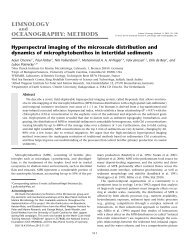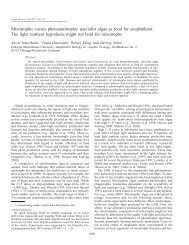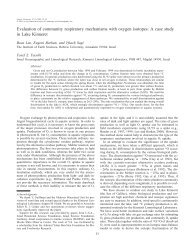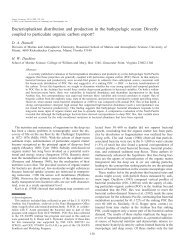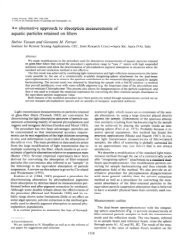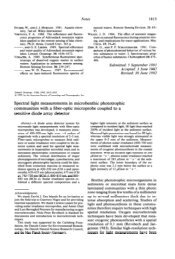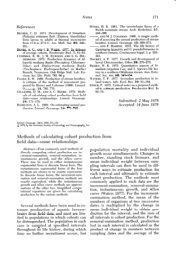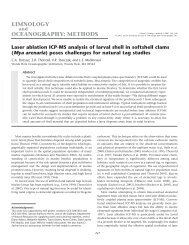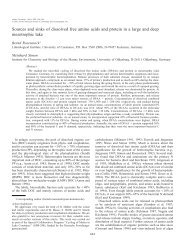Tina van de Flierdt, Katharina Pahnke, and GEOTRACES ... - ASLO
Tina van de Flierdt, Katharina Pahnke, and GEOTRACES ... - ASLO
Tina van de Flierdt, Katharina Pahnke, and GEOTRACES ... - ASLO
Create successful ePaper yourself
Turn your PDF publications into a flip-book with our unique Google optimized e-Paper software.
<strong>van</strong> <strong>de</strong> <strong>Flierdt</strong> et al. Seawater Nd Isotopes: Intercalibration<br />
Table 1b: Details for processing seawater samples for Nd concentrations <strong>and</strong> other rare earth element concentrations in different laboratories.<br />
lab concentrations aliquoting spike technique mass spectrometry<br />
ICP-MS<br />
seaFAST system with a column containing resin with<br />
ethylenediaminetriacetic acid <strong>and</strong> iminodiacetic acid<br />
functional groups to preconcentrate REE<br />
1 [REE] 4mL aliquot no<br />
2 [Nd], [Sm] spiked large volume sample for isotope work with 150 Nd <strong>and</strong> 149 Sm <strong>and</strong> processed as <strong>de</strong>scribed in Table 1a MC-ICP-MS<br />
MC-ICP-MS<br />
co-precipitated REE with Fe; RE spec ion<br />
chromatography with ad<strong>de</strong>d ascorbic acid to reduce<br />
Fe<br />
mixed REE spike ( 138 La, 142 Ce, 145 Nd, 149 Sm, 153 Eu,<br />
155 161 167 171<br />
Gd, Gd, Er, <strong>and</strong> Yb)<br />
3 [REE] 50 to 150mL aliquot<br />
ICP-MS<br />
solvent extraction following Shabani et al (1992)<br />
except for sample 513, for which REE were coprecipitated<br />
with 8mg of or Fe followed by anion<br />
exchange chemistry<br />
5 [REE] 500 ml aliquot 145 Nd <strong>and</strong> Indium<br />
6 [Nd], [Sm] spiked entire sample with 150 Nd <strong>and</strong> 147 Sm <strong>and</strong> processed as <strong>de</strong>scribed in Table 1a TIMS<br />
ICP-MS<br />
co-precipitated REE with 2.5mg Fe; anion exchange<br />
column<br />
8 [REE] 500mL aliquot 150 Nd, 172 Yb<br />
9 [Nd] 500mL aliquot 145 Nd co-precipitated REE with Fe; anion exchange column ICP-MS<br />
10 [REE] 600 mL aliquot ~20 µg Tm solution (100.2 ppm) co-precipitated REE with 1ml 1000ppm Fe solution ICP-MS<br />
11 [Nd] 250 mL aliquot 146 Nd co-precipitated REE with Fe; RE Spec column ICP-MS<br />
12 [Nd] spiked large volume for isotope work with 150 Nd <strong>and</strong> processed as <strong>de</strong>scribed in Table 1a TIMS<br />
16 [REE] 180-190g of seawater 145 Nd, 171 Yb co-precipitated REE with Fe; anion exchange column ICP-MS<br />
238<br />
ICP-MS<br />
co-precipitated REE with Fe; cation exchange column,<br />
Mitsubishi resin column; Re <strong>and</strong> Rh as internal<br />
no<br />
10L of seawater; used a fraction of the REE<br />
cut from column chemistry<br />
17* ,a [REE]<br />
st<strong>and</strong>ards<br />
MC-ICP-MS<br />
preconcentration of REE on C-18 cartridges; Ln Spec<br />
column<br />
17 b [Nd] 500mL aliquot 150 Nd<br />
* seawater concentrations were calculated assuming a total sample volume of 10L for the two intercalibration samples from BATS<br />
a<br />
method used for intercalibration samples from BATS<br />
b method used for analyses of unknown REE st<strong>and</strong>ard<br />
Table 1b.<br />
bani et al. 1992; see Table 1a). Barium<br />
was subsequently eluted from the cartridges<br />
using 5 mL 0.01M HCl <strong>and</strong> the<br />
REE were collected in 35 mL 6M HCl.<br />
Following preconcentration of Nd,<br />
chemical separation of Nd from the<br />
sample matrix is required to minimize<br />
possible interferences during subsequent<br />
analyses by mass spectrometry.<br />
Depen<strong>de</strong>nt on the column set up, high<br />
Fe concentrations in initial sample<br />
solutions can be a problem. Hence, a<br />
few laboratories reduced the amount of<br />
Fe in an initial step by st<strong>and</strong>ard anion<br />
exchange chromatography (e.g.,<br />
Hooker et al. 1975), isopropyl ether<br />
back extraction (Dodson et al. 1936), or<br />
Fe reduction through the use of ascorbic<br />
acid. Most laboratories however<br />
applied a two-step ion chromatography,<br />
with a first column to separate REE<br />
from the sample matrix, <strong>and</strong> a second<br />
column to separate REEs from each<br />
other (see Table 1a). For the first column,<br />
the st<strong>and</strong>ard cation exchange<br />
procedure using elution with HCl of<br />
increasing molarities (e.g., White <strong>and</strong><br />
Patchett 1984) is the most frequent<br />
choice (note: some laboratories use an<br />
initial step of eluting some of the sample<br />
matrix with HNO 3 before switching<br />
over to HCl). The more recently <strong>de</strong>veloped<br />
Eichrom ion exchange resins, TRU<br />
Spec <strong>and</strong> RE Spec, <strong>and</strong> elution using<br />
HNO 3 <strong>and</strong> HCl in succession (e.g., Pin<br />
<strong>and</strong> Zalduegui 1997) were used by a<br />
number of laboratories. The second column<br />
is either based on cation exchange<br />
chromatography with a-hydroxyisobutyric<br />
acid (a-HIBA) to sequentially elute<br />
the various REEs from heavy to light<br />
(e.g., Eugster et al. 1970; Lugmair et al.<br />
1975), or a reversed-phase chromatography<br />
using beads coated with HDEHP<br />
[di(2-ethylhexyl)orthophosphoric acid]<br />
(Richard et al. 1976) to sequentially<br />
elute the REE from light to heavy. Over<br />
the past years the latter has been<br />
increasingly replaced by Eichrom’s Ln<br />
Spec resin (Pin <strong>and</strong> Zalduegui 1997).<br />
Neodymium isotopic ratios were<br />
measured by Thermal Ionization Mass<br />
Spectrometry (TIMS: Triton, Finnigan<br />
MAT 261 <strong>and</strong> 262, VG Sector, VG Sector




